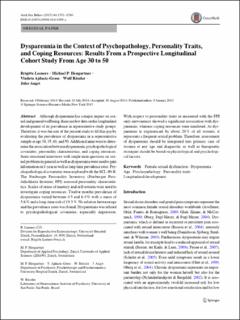Please use this identifier to cite or link to this item:
https://doi.org/10.21256/zhaw-2286Full metadata record
| DC Field | Value | Language |
|---|---|---|
| dc.contributor.author | Leeners, Brigitte | - |
| dc.contributor.author | Hengartner, Michael Pascal | - |
| dc.contributor.author | Ajdacic-Gross, Vladeta | - |
| dc.contributor.author | Rössler, Wulf | - |
| dc.contributor.author | Angst, Jules | - |
| dc.date.accessioned | 2018-01-30T13:48:47Z | - |
| dc.date.available | 2018-01-30T13:48:47Z | - |
| dc.date.issued | 2015-08 | - |
| dc.identifier.issn | 0004-0002 | de_CH |
| dc.identifier.issn | 1573-2800 | de_CH |
| dc.identifier.uri | https://digitalcollection.zhaw.ch/handle/11475/2286 | - |
| dc.description | Erworben im Rahmen der Schweizer Nationallizenzen (http://www.nationallizenzen.ch) | de_CH |
| dc.description.abstract | Although dyspareunia has a major impact on sexual and general well-being, there are few data on the longitudinal development of its prevalence in representative study groups. Therefore, it was the aim of the present study to fill this gap by evaluating the prevalence of dyspareunia in a representative sample at age 30, 35, 41, and 50. Additional aims were to determine the association between dyspareunia, psychopathological covariates, personality characteristics, and coping resources. Semi-structured interviews with single-item questions on sexual problems in general as well as dyspareunia were used to gain information on 1-year as well as long-time prevalence rates. Psychopathological covariates were explored with the SCL-90-R. The Freiburger Personality Inventory (Freiburger Persönlichkeits Inventar, FPI) assessed personality characteristics. Scales of sense of mastery and self-esteem were used to investigate coping resources. Twelve months prevalence of dyspareunia varied between 4.5 and 6.4% with a mean of 5.6% and a long-time risk of 19.3%. No relation between age and the prevalence rates was found. Dyspareunia was related to psychopathological covariates, especially depression. With respect to personality traits as measured with the FPI only nervousness showed a significant association with dyspareunia, whereas coping resources were unrelated. As dyspareunia is experienced by about 20% of all women, it represents a frequent sexual problem. Therefore, assessment of dyspareunia should be integrated into primary care of women at any age and diagnostic as well as therapeutic strategies should be based on physiological and psychological factors. | de_CH |
| dc.language.iso | en | de_CH |
| dc.publisher | Springer | de_CH |
| dc.relation.ispartof | Archives of Sexual Behavior | de_CH |
| dc.rights | Licence according to publishing contract | de_CH |
| dc.subject | Female sexual dysfunction | de_CH |
| dc.subject | Dyspareunia | de_CH |
| dc.subject | Age | de_CH |
| dc.subject | Psychopathology | de_CH |
| dc.subject | Personality traits | de_CH |
| dc.subject | Longitudinal development | de_CH |
| dc.subject.ddc | 616.89: Psychische Störungen, klinische Psychologie und Psychiatrie | de_CH |
| dc.subject.ddc | 618: Geburtsmedizin und Hebammenarbeit | de_CH |
| dc.title | Dyspareunia in the context of psychopathology, personality traits, and coping resources : results from a prospective longitudinal cohort study from age 30 to 50 | de_CH |
| dc.type | Beitrag in wissenschaftlicher Zeitschrift | de_CH |
| dcterms.type | Text | de_CH |
| zhaw.departement | Angewandte Psychologie | de_CH |
| zhaw.organisationalunit | Psychologisches Institut (PI) | de_CH |
| dc.identifier.doi | 10.1007/s10508-014-0395-y | de_CH |
| dc.identifier.doi | 10.21256/zhaw-2286 | - |
| zhaw.funding.eu | No | de_CH |
| zhaw.issue | 6 | de_CH |
| zhaw.originated.zhaw | Yes | de_CH |
| zhaw.pages.end | 1560 | de_CH |
| zhaw.pages.start | 1551 | de_CH |
| zhaw.publication.status | publishedVersion | de_CH |
| zhaw.volume | 44 | de_CH |
| zhaw.publication.review | Peer review (Publikation) | de_CH |
| zhaw.webfeed | Klinische Psychologie | de_CH |
| Appears in collections: | Publikationen Angewandte Psychologie | |
Files in This Item:
| File | Description | Size | Format | |
|---|---|---|---|---|
| 2015_Leeners_Dyspareunia-in-the-Context-Of-Psychopathology.pdf | 386.86 kB | Adobe PDF |  View/Open |
Show simple item record
Leeners, B., Hengartner, M. P., Ajdacic-Gross, V., Rössler, W., & Angst, J. (2015). Dyspareunia in the context of psychopathology, personality traits, and coping resources : results from a prospective longitudinal cohort study from age 30 to 50. Archives of Sexual Behavior, 44(6), 1551–1560. https://doi.org/10.1007/s10508-014-0395-y
Leeners, B. et al. (2015) ‘Dyspareunia in the context of psychopathology, personality traits, and coping resources : results from a prospective longitudinal cohort study from age 30 to 50’, Archives of Sexual Behavior, 44(6), pp. 1551–1560. Available at: https://doi.org/10.1007/s10508-014-0395-y.
B. Leeners, M. P. Hengartner, V. Ajdacic-Gross, W. Rössler, and J. Angst, “Dyspareunia in the context of psychopathology, personality traits, and coping resources : results from a prospective longitudinal cohort study from age 30 to 50,” Archives of Sexual Behavior, vol. 44, no. 6, pp. 1551–1560, Aug. 2015, doi: 10.1007/s10508-014-0395-y.
LEENERS, Brigitte, Michael Pascal HENGARTNER, Vladeta AJDACIC-GROSS, Wulf RÖSSLER und Jules ANGST, 2015. Dyspareunia in the context of psychopathology, personality traits, and coping resources : results from a prospective longitudinal cohort study from age 30 to 50. Archives of Sexual Behavior. August 2015. Bd. 44, Nr. 6, S. 1551–1560. DOI 10.1007/s10508-014-0395-y
Leeners, Brigitte, Michael Pascal Hengartner, Vladeta Ajdacic-Gross, Wulf Rössler, and Jules Angst. 2015. “Dyspareunia in the Context of Psychopathology, Personality Traits, and Coping Resources : Results from a Prospective Longitudinal Cohort Study from Age 30 to 50.” Archives of Sexual Behavior 44 (6): 1551–60. https://doi.org/10.1007/s10508-014-0395-y.
Leeners, Brigitte, et al. “Dyspareunia in the Context of Psychopathology, Personality Traits, and Coping Resources : Results from a Prospective Longitudinal Cohort Study from Age 30 to 50.” Archives of Sexual Behavior, vol. 44, no. 6, Aug. 2015, pp. 1551–60, https://doi.org/10.1007/s10508-014-0395-y.
Items in DSpace are protected by copyright, with all rights reserved, unless otherwise indicated.